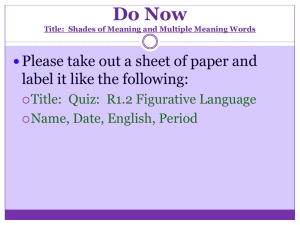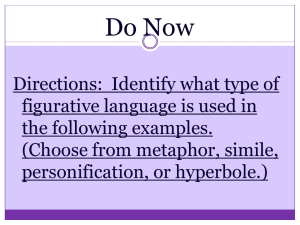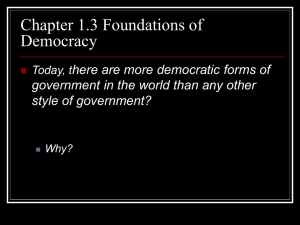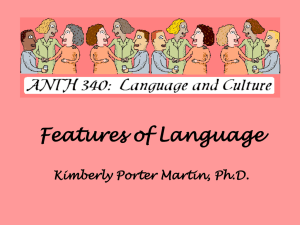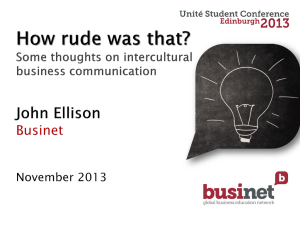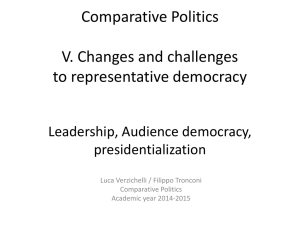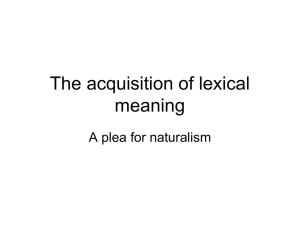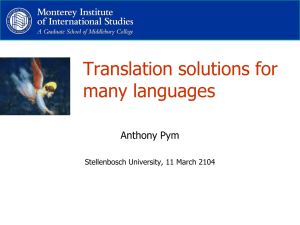Keynote presentation by Helge Jordheim
advertisement
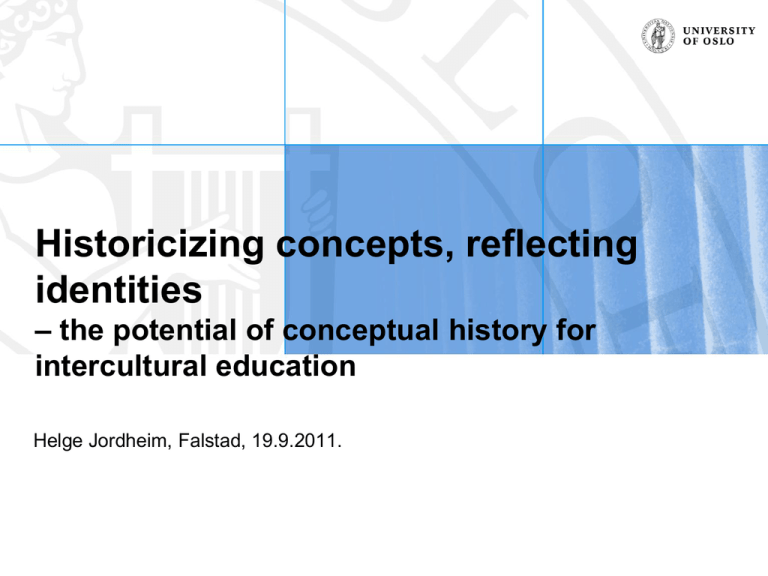
Historicizing concepts, reflecting identities – the potential of conceptual history for intercultural education Helge Jordheim, Falstad, 19.9.2011. 1. 2. 3. 4. 5. 6. Intro: Democracy – openness – humanity The Nietzschean Credo Begriffsgeschichte – the origins Begriffsgeschichte – theory Begriffsgeschichte – method Conceptual history in intercultural education A great people has been moved to defend a great nation . Our answer is more democracy, more openness, more humanity. Democracy – openness – humanity 1. Positivist (realist) approach: concepts as ’windows to the world’, f. ex. democracy is government by the people 2. Pragmatist approach: concepts as (more or less formal) agreements, f. ex. in this context we take openness to mean freedom of speech 3. Hermeneutical-phenomenological (constructivist) approach: concepts as aggregates of different experiences, meanings and uses, f. ex. Humanität as the goal of humankind (Herder) or as act of kindness The Nietzschean Credo All concepts, in which an entire process is summarized semiotically, eludes definition: only that which has no history, can be defined Alle Begriffe, in denen sich ein ganzer Prozeß semiotisch zusammenfaßt, entziehen sich der Definition; definierbar ist nur das, was keine Geschichte hat. (Nietzsche, Zur Genealogie der Moral) Begriffsgeschichte – the origins Geschichtliche Grundbegriffe. Lexikon zur historisch-sozialen Sprache in Deutschland (“Key Historical Concepts. Encyclopedia of German Historico-Social Language”). Edited by Otto Brunner, Werner Conze and Reinhart Koselleck, Stuttgart: Klett-Cotta 1972-1992 (but also: Historisches Wörterbuch der Philosophie by Joachim Ritter and Handbuch politisch-sozialer Grundbegriffe in Frankreich 1680-1820 by Rolf Reichardt etc.) Begriffsgeschichte – the origins Historical aim: To study the dissolution of the old world and the emergence of the new world through the history of how it has been conceptualized. (Koselleck 1967) Educational and political aim: To alienate the concepts through past experiences can contribute to a contemporary raising of awareness that leads from historical clarification to political clarity. (Koselleck 1972) Begriffsgeschichte – theory • Both words and concept might have several meanings, but whereas the meaning of a word can be determined with reference to the context, concepts are by necessity ambiguous. • The word becomes a concept when the plenitude of a social and political context of meaning, in which – and for which – the word is used, is taken up in the word. • The concept assembles the plurality of historical experiences as well as a series of theoretical and historical issues in one single whole, which is only given in the concept itself and only can be experienced there. • Not only the plurality of meaning and experience, but even ‘the plurality of historical reality enters into the ambiguity of a concept. Begriffsgeschichte – theory • key/ basic concepts [Grundbegriffe]: irreplacable parts of political and social langue – always controversial and contested • all concepts are parts of larger semantic fields (or discourses) Begriffsgeschichte – method • synchronic analysis: contextualization, uses and meanings within a specific context, a rhetorical situation, a historical moment, pragmatic (who? why? in what way?), intentions, effects etc. • diachronic narrative: different meanings and uses added together diachronically to a history for the concept • comparative element – works both synchronically an diachronically Historicizing concepts, reflecting identities – conceptual history in intercultural education 1. Mapping the plenitude of meanings and uses a) synchronically – across personal identities and biographies – across cultural, social and political differences – across different languages b) diachronically – through history (past, present and future) – including the present historical situation or moment (historicity) Historicizing concepts, reflecting identities – conceptual history in intercultural education 2. Negotiating meanings and uses a) communication – in the same room or digitally across geographical distances – language (the problem of English as a metalanguage) b) reciprocity – recognition (Anerkennung) – symmetry (of power, knowledge etc.) c) dynamics – movement, transformations (towards agreement?) – but also: immobility, constance, antagonism A great people has been moved to defend a great nation . Our answer is more democracy, more openness, more humanity.


